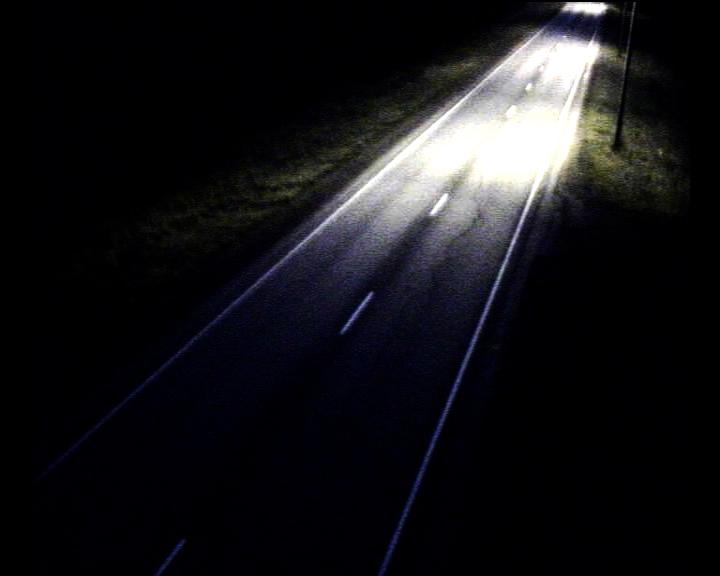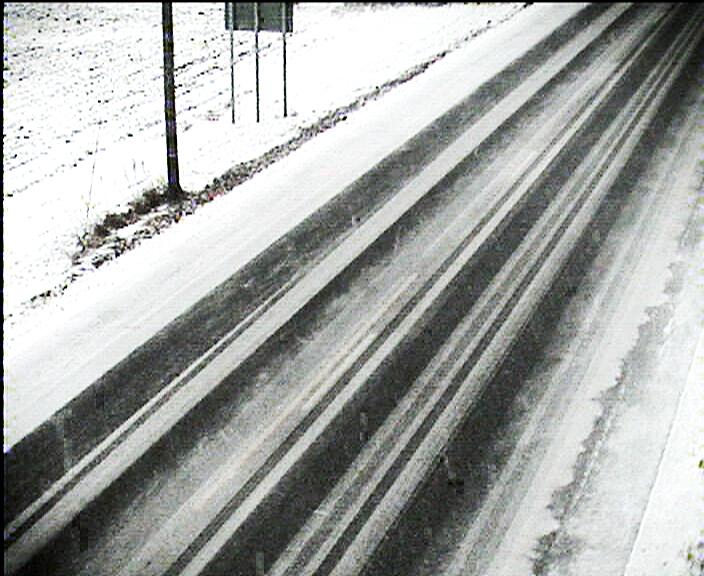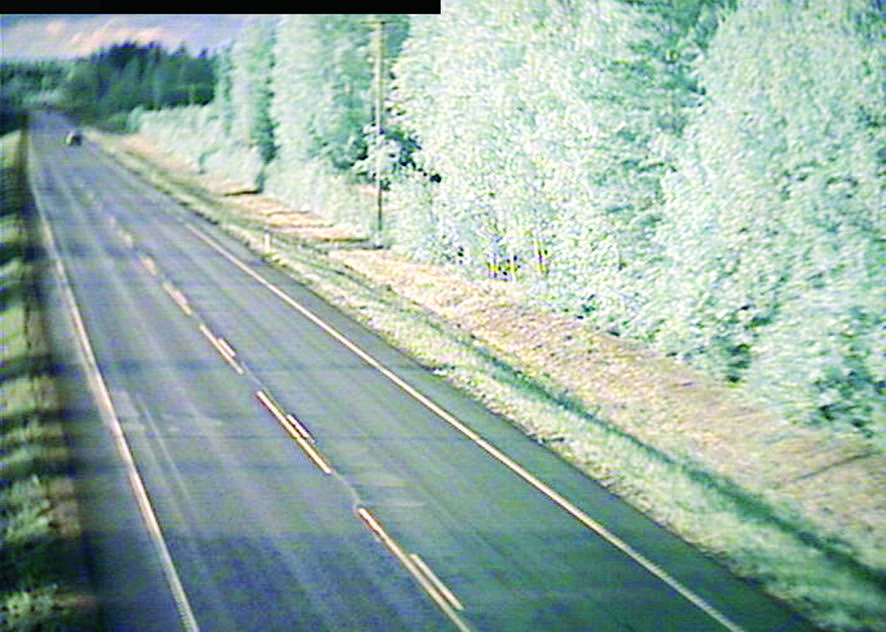Luukkaankangas – updated, revisited
In Finnland, webcams of the Finnish Road Administration record permanently pictures of all important roads. These images are then placed in the internet in an interval of fifteen to thirty minutes. Before their departure, the Finns thus first can read back their streets as an image to decide whether they use them or not. Crucial is perhaps that the cameras record the images automatically without cameraman, they thus are mere function-images without any aesthetical reference. The systematic blank on the part of the production faces a highly individualized reception.
Dariusz Kowalski (Krzeczek) – himself user of these images – designs a singular cinematic dramaturgy out of them. The serial montage of the individual images, their disfunctionalizing and gathering lets these become readable as completely different images. Through the study the streets experience a peculiar animation, inspiration. They are perceived as organisms that are changing with the play of ligths and shades, with the weather conditions and seasons. The streets pulsate, vibrate, mutate according to seemingly mysterious laws. They impress, since often no cars are seen, as a formation with self-referential character.
Positioned in elevated locations, the recordings fabricate a distanced, controlled vizualization of the street blocks. Foucault says: "The more anonymous and functional the power becomes, the more individualized become those who are subjected to this power". The more intense the Road Administration´s power controls the streets by means of webcams, the more these appear as individuals, as unique organisms, claiming each on its own a particular aesthetical way of existance. Perhaps, the country roads and highways are given proper names, in order to do justice to their individualization.
(Marc Ries, © medienturm graz)
The video Luukkaankangas – updated, revisited deals with the traffic landscape of the motor highways and motorways in Finnland. They represent the dispositiv of today’s mobility that implicates a specific understanding of space. They form transit spaces without defining a historical or geographic reference point. The video work abstracts the road traffic-related task of the street and focuses its formal image as a line, lane or hieroglyph in the landscape.
In Finnland, there exists a country-wide road control system (Finnish Road Administration), which photographs motorways and country roads with respect to their weather condition via webcams, and feeds the internet with the information at an interval of about 15-30 min.
For the realization of the video installation Luukkaankangas – updated, revisited, more than 20.000 single photos were taken from the internet.
(Dariusz Kowalski)
Translation: Helga Droschl
Claudia Slanar zu Luukkaankangas
(Claudia Slanar in Barbara Pichler, Andrea Pollach (ed): moving landscapes Landschaft und Film. Synema 2006)
Notions on “LUUKKAANKANGAS - updated, revisited” (EN)
Text: Marc Ries
1.
The image of the street in the work of Dariusz Kowalski exists already beforehand, in a manner of speaking as an a priori. One could perhaps formulate it this way: the condition of the possibility to have street as image, lies in the social-historical compulsion to double everything real-existing as imaginary, better: as medial one. To the twenty-first century applies, that all experience is preceded already by an image of the to-be-experienced. This has nothing to do with culture industry, but with an ontological regrouping. The image is, in accordance with today´s aesthetical theory, not any more last element of a being-hierarchy, but equal part to all other elements, foremost to thought. An iconic paradigm - in medicine, the natural sciences and humanities, but also in the military research - manifests itself against the logical-symbolic paradigm of the early twentieth century: an iconic turn is added to the linguistic turn .
“Visualization” has advanced to a cognition-theoretical leading figure of many fields of our culture, to which experience and knowledge have to submit. These are dependent on, first of all result, representatives of the results of the visualization. Also, it does not surprise that in Finnland on all important roads, webcams of the Finnish Road Administration record or photograph the street as such, in its being as it is, in its “condition”; these images are then placed in the internet in an interval of fifteen to thirty minutes. Before their departure, the Finns thus first can read back their streets as an image, to visualize an image of the streets and to decide whether they use them, pass over them or not. Crucial is perhaps that the cameras record the images automatically without cameraman, they thus are mere function-images without any aesthetical reference. The systematic blank on the part of the production faces a highly individualized reception. The iconic verifyability of the quality of the street is a pleasure-oriented procedure, everyone is enabled to motivate his agency qua image - not just by means of language or other sign systems. Presumably, the actual trip on the streets then becomes a real-road-movie.
2.
The manipulation of the individual images, produced by Dariusz Krzeczek in animated video sequences, is a plausible consequence of this logic of acting. The user Kowalski designs a singular cinematic dramaturgy of the images, which he appropriates himself . According to the author, the video, “abstract of the traffic-related task of the street images, focuses on the formal image of the street as line, lane or hieroglyph in the landscape”. The serial montage of the individual images, their disfunctionalizing and gathering, partly in diachronic, partly in synchronous combinations, lets these become readable as completely different images. Through the study the streets experience a peculiar animation, inspiration. They are perceived as organisms that are changing with the play of ligths and shades, with the weather conditions and seasons. The streets pulsate, vibrate, mutate according to seemingly mysterious laws. They impress, since often no cars are seen, as a formation with self-referential character. And when automobiles flare up as out of the nothingness, then they are rather citings of themselves, than independent referees. Dariusz Kowalski entitles his work “aesthetical analysis”; the images, they exist already as found-footage material of a street control- and multi media system - the point now is to superelevate them by means of specific procedures, to submit them to an interpretation which shows its motif, the street, in such a way as it hardly has been read and understood before. The industrial artefact street experiences in these animations a “resurrection” as aesthetical one, is recognized as image and comprehended as individuum. This observation is supported by the “frame work” (Polyani) of the webcam-images, meaning the always constant remaining long shot from the bird´s-eye view. Positioned in elevated locations, the recordings fabricate a distanced, controlled vizualization of the street blocks, trying to offer a nearly complete “supervision” of the area. All this in a peculiar manner meets Foucault´s comments on individualization as effect of discipline and control: “the more anonymous and functional the power becomes, the more individualized become those who are subjected to this power”. The more intense the Road Administration´s power controls the streets by means of webcams, the more these appear as individuals, as unique organisms, claiming each on its own a particular aesthetical way of existance. Perhaps, the country roads, motor highways and motorways are given proper names, in order to do justice to their individualization.
Notions on “LUUKKAANKANGAS - updated, revisited” (EN)
Text: Marc Ries
1.
The image of the street in the work of Dariusz Kowalski exists already beforehand, in a manner of speaking as an a priori. One could perhaps formulate it this way: the condition of the possibility to have street as image, lies in the social-historical compulsion to double everything real-existing as imaginary, better: as medial one. To the twenty-first century applies, that all experience is preceded already by an image of the to-be-experienced. This has nothing to do with culture industry, but with an ontological regrouping. The image is, in accordance with today´s aesthetical theory, not any more last element of a being-hierarchy, but equal part to all other elements, foremost to thought. An iconic paradigm - in medicine, the natural sciences and humanities, but also in the military research - manifests itself against the logical-symbolic paradigm of the early twentieth century: an iconic turn is added to the linguistic turn .
“Visualization” has advanced to a cognition-theoretical leading figure of many fields of our culture, to which experience and knowledge have to submit. These are dependent on, first of all result, representatives of the results of the visualization. Also, it does not surprise that in Finnland on all important roads, webcams of the Finnish Road Administration record or photograph the street as such, in its being as it is, in its “condition”; these images are then placed in the internet in an interval of fifteen to thirty minutes. Before their departure, the Finns thus first can read back their streets as an image, to visualize an image of the streets and to decide whether they use them, pass over them or not. Crucial is perhaps that the cameras record the images automatically without cameraman, they thus are mere function-images without any aesthetical reference. The systematic blank on the part of the production faces a highly individualized reception. The iconic verifyability of the quality of the street is a pleasure-oriented procedure, everyone is enabled to motivate his agency qua image - not just by means of language or other sign systems. Presumably, the actual trip on the streets then becomes a real-road-movie.
2.
The manipulation of the individual images, produced by Dariusz Krzeczek in animated video sequences, is a plausible consequence of this logic of acting. The user Kowalski designs a singular cinematic dramaturgy of the images, which he appropriates himself . According to the author, the video, “abstract of the traffic-related task of the street images, focuses on the formal image of the street as line, lane or hieroglyph in the landscape”. The serial montage of the individual images, their disfunctionalizing and gathering, partly in diachronic, partly in synchronous combinations, lets these become readable as completely different images. Through the study the streets experience a peculiar animation, inspiration. They are perceived as organisms that are changing with the play of ligths and shades, with the weather conditions and seasons. The streets pulsate, vibrate, mutate according to seemingly mysterious laws. They impress, since often no cars are seen, as a formation with self-referential character. And when automobiles flare up as out of the nothingness, then they are rather citings of themselves, than independent referees. Dariusz Kowalski entitles his work “aesthetical analysis”; the images, they exist already as found-footage material of a street control- and multi media system - the point now is to superelevate them by means of specific procedures, to submit them to an interpretation which shows its motif, the street, in such a way as it hardly has been read and understood before. The industrial artefact street experiences in these animations a “resurrection” as aesthetical one, is recognized as image and comprehended as individuum. This observation is supported by the “frame work” (Polyani) of the webcam-images, meaning the always constant remaining long shot from the bird´s-eye view. Positioned in elevated locations, the recordings fabricate a distanced, controlled vizualization of the street blocks, trying to offer a nearly complete “supervision” of the area. All this in a peculiar manner meets Foucault´s comments on individualization as effect of discipline and control: “the more anonymous and functional the power becomes, the more individualized become those who are subjected to this power”. The more intense the Road Administration´s power controls the streets by means of webcams, the more these appear as individuals, as unique organisms, claiming each on its own a particular aesthetical way of existance. Perhaps, the country roads, motor highways and motorways are given proper names, in order to do justice to their individualization.



